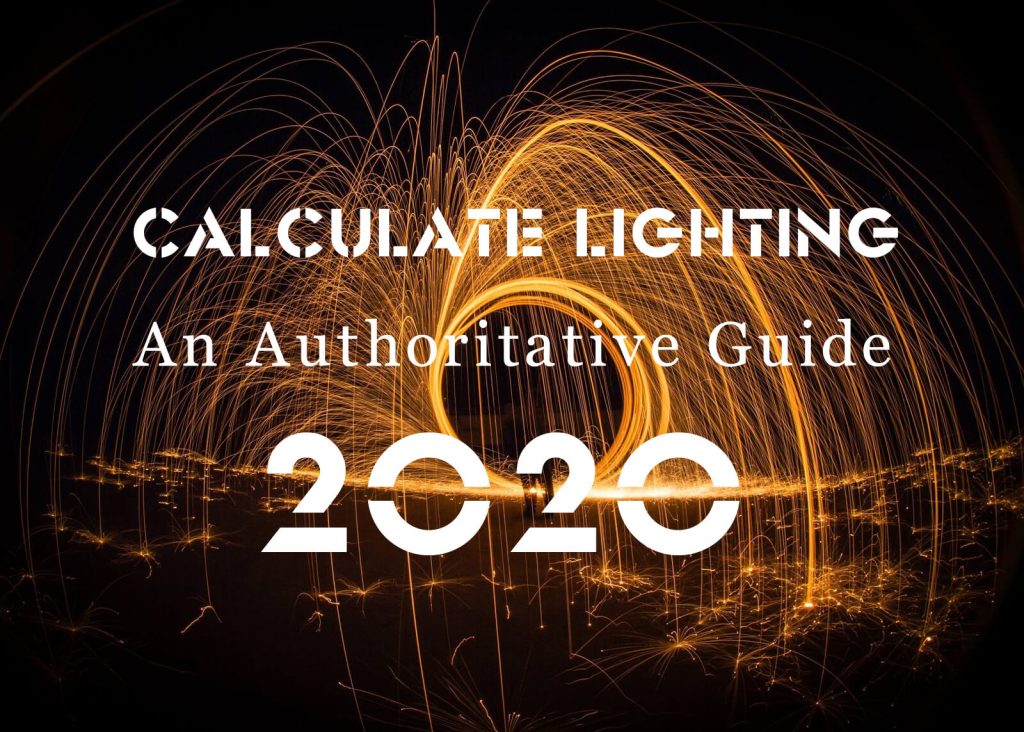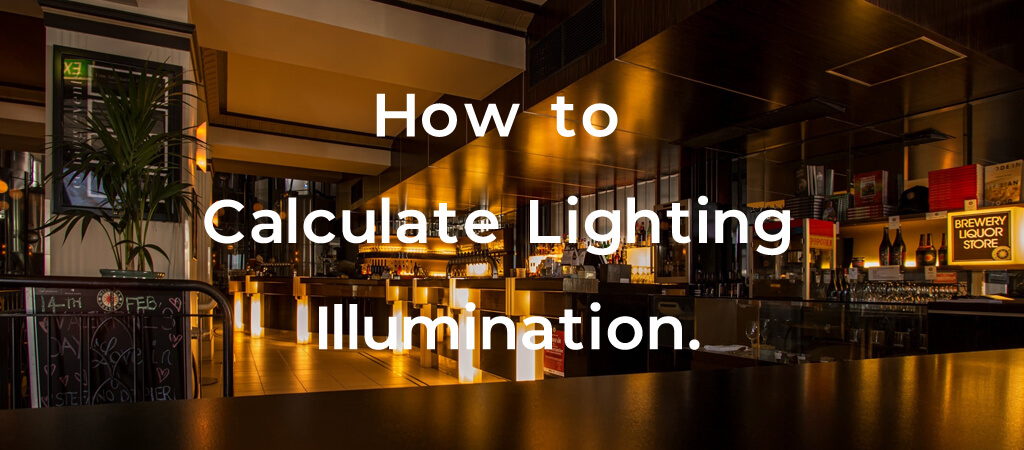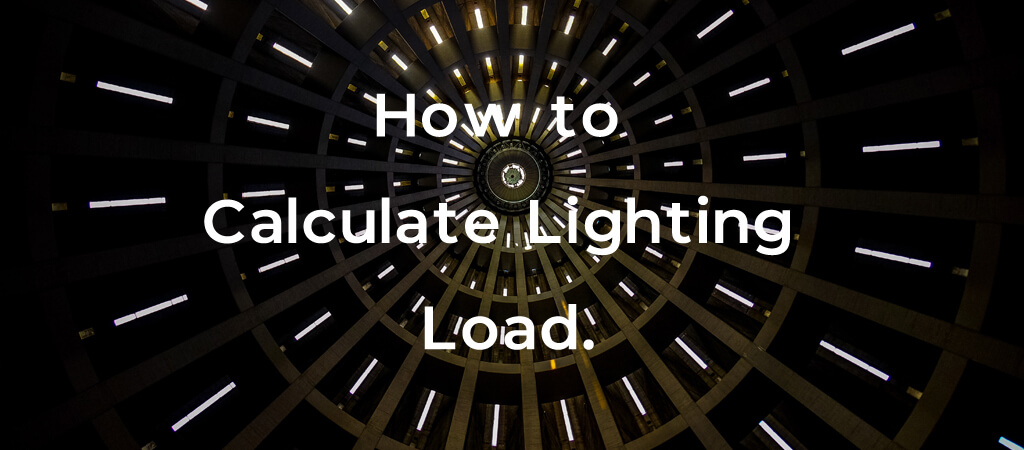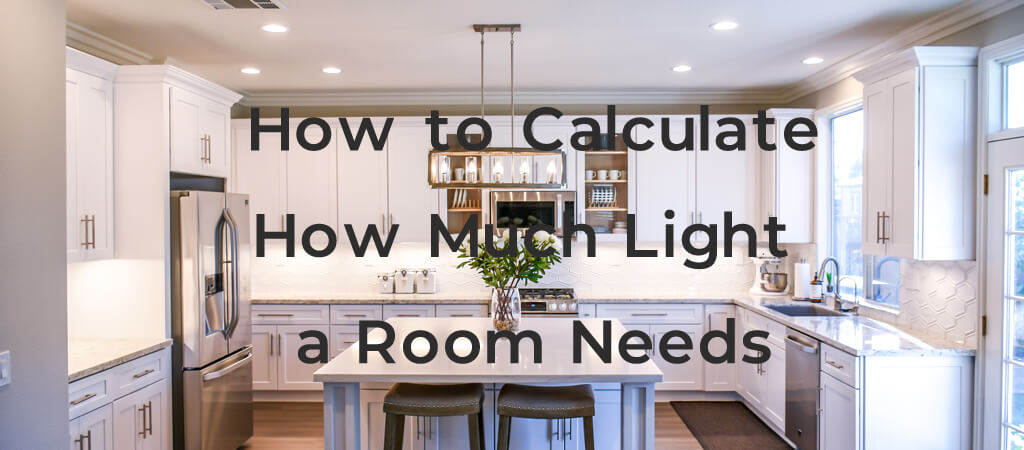How to Calculate Lighting: An Authoritative Guide
How is Light Calculated?
It is a tricky question, right?
However, there are many ways of calculating lighting.
From the lux calculation formula to the conversion of watts to lumens, there are so many ways you can calculate lighting.
Now:
Light calculation can sometimes be simple and, other times, complex. It all depends on the type of calculation being undertaken.
Anyway, this post focuses on all types of ways to calculate lighting.
By the end of your reading, you’ll have learned about things like:
- How to calculate the lighting needs of a space?
- How to measure light efficacy?
- How to calculate the distance of light?
- How to measure lux levels?
- How to calculate lumens per watt?
And so on…

Why do you need to know all this information?
Well, aside from bolstering your knowledge of lighting, it will also make it easier for you to determine:
- How many fixtures you need to comfortably light up your space.
- Ways of increasing the efficiency of your lighting system.
- Which light technology and fixtures are best suited for you among other things…
So, what are you waiting for?
Get your pen and paper and let’s get down to the calculations.
Common Methods Used to Calculate Lighting
Lighting can be calculated in many ways.
For example:
You might want to know how much energy your light fixtures will be consuming at any given time. Or better yet, the amount of luminous flux produced by your lighting fixtures.
The reasons or purposes are endless!
This is why interior designers, lighting contractors and even you have to know how to calculate lighting.
With that in mind, here is a brief overview of the most common ways to calculate illumination:
- How to Calculate Lighting Illumination
- How to Calculate Lighting Needs
- How to Calculate Lighting Load
- How to Calculate Lux Levels
- How to Calculate Efficacy
- How to Calculate kWh Costs for Lighting
- How to Calculate How Much Light a Room Needs
- How to Calculate LED Power
- How to Calculate Lumens per Watt
- How to Calculate Distance of Light
- How to Calculate Recommended Lighting Levels for Office & Computer Work
Enjoy it.
1. How to Calculate Lighting Illumination
When it comes to illumination calculation, there are two main approaches.
We can use:
- The Wattage
- Or, the Lumens
Both formulas differ in some ways. However, they can be used to calculate lighting illumination.
So:
How do you go about doing both of these calculations?
Well, first, you’ll need to find a tape measure and a calculator. Once you have both of these tools you’ll be all set to begin your calculations.
Here’s how it’s done…

- THE WATTAGE FORMULA (Watts per Square Foot)
This method makes it easier for you to determine how much light you need to comfortably illuminate your space.
How?
For example:
Let’s assume that you have a 10-by-10 foot room. Your room’s square footage will 100 square feet.
Now, for general lighting needs (living rooms and entertainment areas) you can calculate your wattage needs by multiplying the room’s square footage by 1.5W or 2.5W for work/study rooms.
In our 10-by-10 foot room example, you’ll end up with 150W for general use or 250W for work/study rooms.
Note:
For work areas, task lighting is always more efficient because it helps you to direct light to the important areas of the room; e.g. your study desk.
Recommended products: LED tri-proof light, LED Panel light
Moving on…
- THE LUMEN CALCULATOR FORMULA (Lumens per Square Foot)
First of all…
Lumens per square foot or a foot-candle or lux is the amount of light an area is receiving.
To do this calculation, you have to:
- Measure your room’s dimensions. E.g. 10-by-10 feet.
- Calculate the total sum of the lumens produced by all of your light sources. Lumen output is often indicated on the fixtures’ packaging or manufacturer’s website.
- Divide your total lumen output by your room’s square footage.
Note:
Different rooms often require a different amount of lighting for clarity, illumination, and safety. Therefore, you have to ensure you know much light is needed per square foot.
In such a case, you can use the watts to lumens calculator.
For example:
If your 10-by-10 foot room is a bathroom, experts recommend that the lux should be close to 75 lumens per square foot.
Therefore, by multiplying 75 by 100, your fixtures need to yield at least 7500 lumens of light in total.
For more details on expert recommendations on lux levels, click here.
Simple, right?
2. How to Calculate Lighting Needs

Why do you need to do this?
Well, calculating lighting needs helps you to know how much electrical power is needed to accommodate your room’s lighting needs.
Now:
To achieve this, you’ll need a light meter to measure light in lumens.
So, how do you go about this?
Well, for starters, your lighting calculation formula needs to concur with the National Electrical Code.
Basically, according to this code, the main electrical systems have to be allotted a load factor of three.
For example:
If your room is 500 square feet, the total lighting wattage allocated for that room should be 1500W (15 100 Watts bulbs).
But:
Remember that a room’s purpose/use is also a crucial factor to consider. Some rooms may need more lighting than others.
Moreover, you should note that bright colors (on walls and ceilings) often reflect light more. Thus, they can be used to maximize the efficiency of your lighting system.
3. How to Calculate Lighting Load

To calculate the lighting load, we use this formula:
Watts = Volts * Amps (or W=VA in short).
In most cases, you’ll get two of these three elements.
For example:
If your household circuits have a 240V capacity and can allow up to 20A of electricity at any given time, then your wattage capacity becomes:
240 Volts * 20 Amps = 4800 Watts
That means that your household has a lighting load of 4800W.
Knowing this tiny bit of information helps you to know how much power you can draw without tripping your circuit breaker.
With that in mind, here’s how to calculate lighting load:
- Obtain your electrical circuit’s amperage from your circuit box.
- Multiple your amperage by your voltage limits.
- Once you have your power load, subtract all other loads from that to know how much you’ll be left with for lighting.
4. How to Calculate Lux Levels

As mentioned above, lux is simply lumens per square foot. Or, the amount of light hitting an area at any given time.
Lux is defined by intensity and brightness.
And, therefore, calculating lux makes it easier for you to determine how powerful and efficient a light fixture is.
Now:
For lux level calculation, there are several ways to go about it:
For example:
You can use the “ E = Φ / A “ formula where:
- Eis the illuminance or lux.
- Φor “phi” is the luminous flux formula in lumens.
- AndA is the surface area where the light touches (m2)
You can also use the “ E = F x UF x MF / A ” formula where:
- E(sometimes denoted as I) is the illuminance.
- F(sometimes denoted as LI) is the average lumens value of the light source.
- UF(sometimes denoted as Cu) is the coefficient of utilization.
- MFis the light source’s maintenance factor.
- And A is the surface area covered by the light source.
Lastly, you can use a light meter or an online lux measurement chart to measure your room’s illuminance.
It’s simpler and faster this way.
5. How to Calculate Efficacy

Now, this is where things tend to get a bit technical.
Why?
Well, it’s because calculating light efficacy can be done in numerous ways.
Note:
The luminous intensity formula depends on three things namely:
- The configuration of the fixture.
- The direction of the light.
- And the distance between the surface and the light source.
With that in mind, here are the steps to take to quickly determine efficacy:
Step 1: Determine the light source’s watt consumption using an LED wattage calculator.
Step 2: Measure the distance “D” (in meters) between the point of interest and your light source.
Step 3: Since light is often distributed in the form of a sphere, you’ll have to find its surface area. To do that you use the formula “ SA = 4 * pi (3.142) * D2 ”.
Step 4: Multiply your SA from step 3 by 4 again.
Step 5: Now, to get the efficacy of light in your point of interest, you’ll have to multiply the answer you get above by pi (3.142) again.
Step 6: Finally, divide the wattage of your light source by the final figure you obtained in step 5 to get a value X. That will give you a final result in the format X Watts per Meters; the efficacy of light at your point of interest.
6. How to Calculate kWh Costs for Lighting

Here, things are a little simpler.
Why?
Because the formula and procedure are quite straightforward.
Here’s how you go about it:
- Calculating Energy Cost Rates
To find out how much you pay for every kWh used, you can use this formula:
Rate = Cost / kWh Total
For example:
If at the end of the month, you receive a $100 for using 1000 kWh of electricity, your cost rate will be:
$100 / 1000 kWh = $0.1 per kWh used
- Calculating Your Lighting Consumption
Once you have a cost rate, the next step would be to calculate your lighting consumption.
Here, we use the following formula:
Lighting Consumption = Number of fixtures * Wattage * Hours used
>> But that is only if all the fixtures have the same wattage; if not, the formula will be:
Lighting Consumption = The Sum of the Wattage from all fixtures * Hours used
For example:
Assuming your room is lit by two 100W bulbs for 6 hours a day. Your total lighting consumption costs will be:
Lighting Costs = 2 fixtures * 100 watts * (6 hours * 30 days) = 36,000 watt-hours used
If one kWh is equal to 1000 watt-hours…
36,000 watt-hours will be equal to 36kWh.
This means that each lighting fixture consumes 18kWh (from 36 / 2) per month, right?
- Calculating Your Lighting Costs
The lighting consumption cost for each bulb can be determined by multiplying its monthly consumption by the cost rate.
For example:
In our case, the cost will be…
18kWh per bulb * $0.1 per kWh used = $1.8 per fixture
It’s easy, isn’t it?
7. How to Calculate How Much Light a Room Needs

If calculating footcandles and lux proved to be a difficult endeavor, this method may come as a relief.
Basically, this is a simpler formula that’s easy to understand and use.
However, it may not be as precise or accurate as some of the other complex methods mentioned above.
How do you go about it?
Well, first you need to find the surface area of your room. That means multiplying its length by width.
For example:
If your room is 10 feet in length and 10 feet in width, your surface area will be 100 Square Feet.
Now:
Generally, experts recommend multiplying the square footage by 1.5 to get the number of watts need to comfortably and adequately illuminate a room.
Therefore, using our example above, our room’s wattage needs will be 150 Watts.
For task-specific rooms like studies, offices, and factories, it is recommended that the square footage be multiplied by 2.5 to determine the room’s wattage needs.
Note:
You can still increase or decrease the wattage amount to meet your preferences and comfortability.
8. How to Calculate LED Power

It’s a fact that LED fixtures are often the most efficient and cost-effective lighting option available today.
However, when you’re dealing with a battery-powered project, calculating LED power becomes a necessity.
Now:
Contrary to how it may sound, it’s quite easy to calculate LED power; especially if you have a multi-meter you can use to measure current, voltage, and resistance.
But, in case you don’t have access to a multi-meter, there is a workaround to this issue.
Often, manufacturers will indicate essential bits of information including voltage and current estimates on the packaging of their light fixtures.
Note:
You only need the voltage and current to calculate LED power.
So, how do you go about it when you don’t have access to a multi-meter?
In principle, you can determine Power by multiplying Voltage by Current.
Therefore, your first step should be to find the voltage of the LED light in use from the manufacturer’s website or packaging.
Sometimes…
You can approximate the voltage using the color of the LED. For example:
- White LEDs = 3.5V.
- Red LEDs = 1.8V.
- Blue LEDs = 3.6V.
- Green, Orange, and Yellow LEDs = 2.1V.
The next step would be to determine the fixture’s current.
You can also get this from the manufacturer’s website, packaging, or by measuring it using an amp meter/multi-meter.
Once you have both the voltage and current, you can then proceed to calculate the fixture’s power.
For example:
If your LED fixture has a voltage of 10V and 0.02A in current, its power (in watts) will be:
10 Volts * 0.02 Amps = 0.2 Watts
Note:
- 1000 Milliwatts = 1 Watt
- 1000 Milliamps = 1 Amp
9. How to Calculate Lumens per Watt

In today’s world, lighting efficiency is quite important. The more efficient a fixture is, the cheaper it is to maintain.
And that’s why this method of calculation is imperative.
When shopping for a light fixture, its Lumens per Watt rating is a critical factor in the decision-making process.
Why?
Well, a fixture is deemed efficient when it outputs more light while using less energy.
Therefore, the higher its Lumens per Watt rating, the more efficient it is.
Now, before we get down to the calculations, you should note:
- A Lumenis a unit of measuring luminous flux or, in simple terms, brightness.
- A Watt is a unit of measuring power. Or, in other words, it is the rate of doing work. Therefore, a fixture’s wattage is the amount of energy it uses to produce light at any given time.
- Not all Watts used by a fixture go to lighting; some are lost in the form of heat.
With that in mind, here’s how to calculate Lumens per Watt:
Here, we use this formula…
Lm/W = Lumens / Watts
For example:
If you have a standard 15W LED fixture that produces 1500 lumens of light, it’s lumens per watt will be:
Lm/W = 1500 / 15 = 100 Lumens per Watt
Fun fact:
A 100W incandescent bulb yields 1300 lumens. Therefore, it has an efficiency of 13 Lumens per Watt.
This means that a 100W incandescent bulb consumes the same energy as seven 15W LED fixtures just to produce the same amount of brightness.
Surprising, right?
10. How to Calculate Distance of Light

What is a Light-Year?
Most people often mistake it for a measure of time. But, it’s actually not!
A Light-Year is a measure of distance. Basically, it is expressing distance using the speed of light.
Because of this, you can have a light-year, light month, light day, light hour, and light minute as units of measuring distance.
Note:
To calculate the distance of light, all you need to do is to multiply the speed of light by the number of seconds in question.
Therefore:
- 1 light second = speed of light * 1
- 1 light minute = speed of light * 1 * 60
- 1 light hour = speed of light * 1 * 60 *60
- 1 light-year = speed of light * 1 * 60 * 60 * 24 * 365.25
So, the distance of light can be calculated using this formula:
dL = ct
Where dL is the distance, c is the speed of light in meters per second, and t is the time in seconds.
Note:
The speed of light is estimated to be around 2.998 × 108 meters per second.
So:
1 light-year = 2.998 × 108 m/s * 60 * 60 * 24 * 365.25 = 9.46 × 1015 m
It’s easy, isn’t it?
In most cases, light-years are used to measure distance in space and between planets/stars among other heavenly bodies. That’s why it is not an everyday phrase.
11. How to Calculate Recommended Lighting Levels for Office & Computer Work

Lastly, let’s look at how to calculate lighting levels in your office and computer work.
The calculations here are also very elementary.
Basically, this method will involve calculating the number of watts needed for lighting up the room in use.
But:
To make things easier, you’ll have to check out all available guidelines and recommendations by lighting professionals in regards to office lighting and computer work.
You should note that unlike general spaces like living rooms, offices and computer rooms have special light needs.
For example:
In any office, you’ll need more light to properly read and work. However, if you are a computer user, too much light and exposure to your PC screen can cause eye discomfort.
So, you have to find the perfect balance here.
And to do so, you’ll need the following guidelines:
Step 1: Using a tape measure, determine the length and width of your space so that you can calculate the surface area.
Step 2: From the professional lighting guidelines, check to see which one best fits your office space and type. These recommendations are often important because they are tailored to give suggestion on the best amount of light intensity that not only promotes an increase in office productivity but also ensure that office users (especially computer users) have a comfortably lit workspace.
Step 3: Once you find the right lumen recommendation for your office, the next step would be to pick out the best spots in your space that can be used for lighting using an LED lighting layout calculator. Remember, when positioning your light fixtures, you need to pay attention to your space’s lighting needs and the most important parts of the room.
Step 4: Divide the lumen recommendation by the number of viable lighting spots in your office to get the exact number of fixtures needed.
Step 5: Go shopping for fixtures that yield the number of lumens you’re looking for. A fixture’s Lux is always indicated on its packaging.
With all that in mind, here’s a practical example:
Assuming you have a 5-by-5 meter office space. Your surface area will be 25m2.
Now:
Lighting experts recommend at least 500 lumens per square meter for office spaces with computers.
Therefore, your lumen requirement will stand at 12,500 lumens (derived from multiplying 25m2 by 500l/m2)
If your room can only accommodate five lighting sources, your lumen requirements per source will be:
12500 / 5 = 2,500 lumens each.
With that information in mind, if you choose to buy LEDs with 100lm/W rating, your wattage requirements can be calculated using this formula:
Wattage = Lumen requirement per fixture / fixture efficiency
In this case, it will be…
2,500 / 100 = 25 Watts per fixture
Yes, it’s that easy.
In Summary…
Sometimes, learning how to calculate lighting can seem like an uphill climb. “Too many complexities,” as some may put it.
However, it’s not always that way.
Evidently, there are so many ways to calculate lighting easily. It’s not rocket science, is it?
Hopefully, you’ve learned a lot from these calculations. This information will help you make better and more efficient decisions when it comes to lighting your home, office, business, and institutions.
We’d Love To Hear From You…
Do you have any questions? Would you like to contribute to the topic? Feel free to post a comment below and we’ll be more than happy to help you gain better insights on the subject. Also, subscribe to our newsletter to stay up-to-date at all times with industry news, innovation, and LED advancements.


8 thoughts on “How to Calculate Lighting: An Authoritative Guide”
You could totally beef up this site by showing the math to calculate the amount of light needed to have 1000 lux (93 foot-candles) at the work-station-surface with varying heights of the light fixture above the surface. This requirement is from an international specification IPC J-STD-001.
I am a junior electrical engineer, and this information was very helpful.
Great
Nizraj H.
June 19, 2022 at 10.34
Hi I need to know which kind of down light and what watts should be used to light up a bag showroom.
The size of a showroom 11.5 meter length X 4.5 meter width X 4.5 meter height.
your kind attention will be much applicated.
Thanks.
hello , I am tasked with figuring out lighting for a community center. it has 9 foot ceilings and is 26X 40 feet . it has 20 , 4 foot flourescent light fixtures now. will 20 surface mounted 6inch led lights 14 watt be enough? I would appreciate any feedback. thanks Michael Longolucco
Hi Michael,
Thanks for your comments.
According to your request, I think it's not enough 14 watts of LED light for your community center.
Please send an email to [email protected], our professional sales will help you calculate the lux and light quantities within 24 hours.
Thank you in advance.
Best regards,
ShineLong Team
I'm a senior and 'old school' when it comes to matching new LED bulbs watts with equal light output as incandescent bulb watts. For example:
LED 14 W = Incandescent ??? W
Just need a simple chart I can print out.
Thanks bunches,
Catherine 💡
need a simple chart indicating
Good point, we will update it in the near future. Thanks.